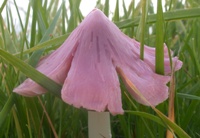Call to protect ‘waxcap’ grasslands

Waxcap
16 October 2013
Wales has some of the most scientifically important and diverse habitats for grassland fungi in the world according to researchers at Aberystwyth University.
Writing in the latest edition of the journal Mycosphere, an international team led by Dr Gareth Griffith from IBERS (Institute of Biological, Environmental and Rural Sciences) also reports the discovery of a new species of mushroom previously unknown to science, and another 13 species that had not been previously recorded in Britain.
Mushroom-forming fungi are generally associated with woodland habitats but the grassy meadows and hills of north-western Europe are home to around 400 species, with intriguing names such as waxcaps, fairy clubs and earth tongues.
However, increased intensification of agriculture over the past 75 years has meant that most of the low nutrient grasslands required by these fungi have been destroyed through ploughing and land improvement.
Dr Griffith and his team recorded the presence and abundance of fungi at 48 grassland sites in all parts of Wales, from Flintshire and Anglesey in the north to Pembrokeshire and Monmouth in the south.
Comparison of their data with information from other areas in Europe and beyond showed that several of the best sites for grassland fungi in Europe and most of the best sites in the UK are in Wales.
These sites are found across Wales, from Llanuwchllyn in Gwynedd to Mynydd Epynt in Powys and Llanishen in Cardiff, and several are now protected as SSSIs (sites of special scientific interest).
Dr Griffith and colleagues hope that publication of this study will lead to wider public recognition of the global significance of these Welsh habitats and fungi in general to biodiversity conservation.
“Most conservation efforts are focused on animals and plants, with many biologists having little appreciation that other living organisms also require protection from habitat loss”, he said.
Dr Griffith also believes that the hilly Welsh terrain has an important role to play in the survival of these fungal-rich areas.
“The abundance of these fungi may be down to that fact that much of Welsh hill land is not accessible to mechanised agriculture, so the soil itself has remained undisturbed”, he added.
However, the study has also revealed that the grassland fungi may have an unexpected ally. They thrive where the grass is kept short, a task performed with meticulous precision by unusually high sheep populations found in Wales.
The study has been funded by the Countryside Council for Wales (now part of Natural Resources Wales) and NERC, Natural Environment Research Council.
The article entitled “The international conservation importance of Welsh 'waxcap' grasslands” is Open Access and available free athttp://mycosphere.org/pdfs/MC4_5_No10.pdf.



